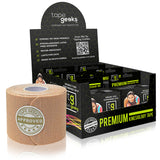
10 Natural Ways to Help Kids Sleep Better
Evidence-Based Strategies for Peaceful Nights (No Medication Required)
🎯 What you'll learn in this guide:
- How to help kids breathe better at night - this is often the biggest game-changer
- Why bedtime routines matter so much - and how to make them stick
- When kids nasal strips can help - they're safe for ages 5+ and work immediately
- How to handle screen time - the real impact on sleep
- Why getting active during the day helps nighttime sleep
Is your child struggling to fall asleep or stay asleep through the night? If you're reading this, chances are you've been there - lying awake at 2 AM wondering why your little one just won't settle down. Trust me, you're not alone in this struggle.
I've talked to hundreds of Canadian parents who've faced the same bedtime battles. The good news? There are some really effective natural ways to help kids sleep better that don't involve any medications or complicated routines. These are the strategies that actually work in real families, not just in research studies.
Why I prefer natural sleep solutions:
- No worrying about side effects or dependency
- They build healthy habits that last a lifetime
- Safe for kids of all ages
- Often work better than quick fixes
In this guide, I'll share 15 natural strategies that have helped thousands of families get better sleep. These aren't just theories - they're practical tips you can start using tonight.
📖 Quick Navigation
1. 🌬️ Help Your Child Breathe Better at Night
This might surprise you, but breathing through the nose instead of the mouth can make a huge difference in how well your child sleeps. I've seen it work for so many families - when kids can breathe easily through their nose, they sleep deeper and wake up less often.
If your child is a mouth breather or snores, it's often because their nose is stuffy or blocked. This forces them to breathe through their mouth, which can lead to restless sleep and even behavioral issues during the day.
Here's what you can try:
- Watch for the signs: Is your child breathing through their mouth? Do they snore? These are clues that nasal breathing might be the issue
- Try kids nasal strips: For children 5 and up, TG Kids Nasal Strips can help open up their nasal passages instantly
- Use saline sprays: A gentle saline spray can help clear out congestion
- Run a humidifier: Dry air can make nasal passages irritated and stuffy
- Manage allergies: If your child has seasonal allergies, treating those can help with nighttime breathing
💡 Pro Tip: Learn more about the science behind nasal breathing in our comprehensive guide: "Do Nasal Strips Really Work? Clinical Insight into Nasal Breathing vs. Mouth Breathing"
2. 🕐 Create a Bedtime Routine That Actually Works
I know, I know - you've probably heard this one before. But here's the thing: a good bedtime routine isn't just about going through the motions. It's about creating a predictable sequence that tells your child's brain "okay, it's time to wind down now."
When you do the same things in the same order every night, your child's body starts to expect sleep. It's like training their internal clock to know when it's bedtime.
Sample Bedtime Routine (30-45 minutes):
🛁
Warm Bath
Raises body temperature, then cooling promotes sleepiness
📚
Story Time
Calming activity that reduces stress
🧘
Relaxation
Deep breathing or gentle stretching
😴
Bedtime
Same time every night
3. 🏠 Create a Sleep-Friendly Environment
Why it works: The bedroom environment significantly impacts sleep quality. Optimal conditions help your child fall asleep faster and stay asleep longer.
Optimal Sleep Environment Checklist:
🌡️ Temperature
- Keep room between 65-70°F (18-21°C)
- Use breathable bedding materials
- Consider a fan for air circulation
🌙 Darkness
- Use blackout curtains or blinds
- Remove or cover electronic lights
- Consider a sleep mask for older children
🔇 Quiet
- Minimize noise disruptions
- Use white noise machine if needed
- Keep bedroom door closed
🛏️ Comfort
- Supportive mattress and pillow
- Comfortable, breathable pajamas
- Remove toys and distractions from bed
4. 📱 Limit Screen Time Before Bed
Why it works: Blue light from screens suppresses melatonin production, making it harder to fall asleep. The stimulating content can also keep children's minds active when they should be winding down.
Screen Time Guidelines:
- No screens 1-2 hours before bedtime
- Remove devices from bedroom to prevent temptation
- Use blue light filters if screens are necessary
- Replace screen time with calming activities like reading or puzzles
- Set a family rule that applies to everyone
5. ⚽ Encourage Daily Physical Activity
Why it works: Regular physical activity helps children fall asleep faster and enjoy deeper sleep. However, timing is important - vigorous exercise too close to bedtime can be counterproductive.
Activity Recommendations:
- 60 minutes of moderate to vigorous activity daily
- Finish intense exercise 3-4 hours before bedtime
- Gentle activities in the evening: walking, stretching, yoga
- Outdoor play: Natural light exposure helps regulate sleep cycles
6. 🥗 Optimize Nutrition for Sleep
Why it works: Certain foods and nutrients can promote better sleep, while others can interfere with sleep quality. Timing of meals also matters.
Sleep-Promoting Foods:
🥛
Warm Milk
Contains tryptophan and calcium
🍌
Bananas
Rich in magnesium and potassium
🥜
Nuts
Almonds and walnuts for melatonin
🍯
Honey
Natural sugar helps tryptophan absorption
Foods to Avoid Before Bed:
- Caffeine: Chocolate, soda, energy drinks
- Sugar: Candy, desserts, sugary cereals
- Spicy foods: Can cause indigestion
- Large meals: Eat dinner 2-3 hours before bedtime
7. ☀️ Manage Light Exposure
Why it works: Light is the most powerful regulator of our sleep-wake cycle. Proper light exposure during the day and darkness at night helps maintain healthy circadian rhythms.
Light Management Strategy:
🌅 Morning Light
- Get 10-15 minutes of natural light upon waking
- Open curtains immediately
- Consider a light therapy lamp in winter
🌆 Evening Dimming
- Dim lights 1-2 hours before bedtime
- Use warm, amber-colored bulbs
- Avoid bright overhead lights
8. 🧘 Teach Stress Management Techniques
Why it works: Stress and anxiety are common causes of sleep problems in children. Teaching relaxation techniques helps them calm their minds and bodies before sleep.
Relaxation Techniques for Kids:
- Deep breathing: "Breathe in for 4, hold for 4, out for 4"
- Progressive muscle relaxation: Tense and relax each muscle group
- Visualization: Imagine a peaceful, happy place
- Mindfulness: Focus on the present moment
- Gratitude practice: Think of 3 good things from the day
9. 🧸 Use Comfort Items Wisely
Why it works: Comfort items can provide security and help children feel safe, but they should be used strategically to promote independence and good sleep habits.
Comfort Item Guidelines:
- Choose appropriate items: Soft toys, blankets, or small comfort objects
- Limit to 1-2 items to avoid clutter in bed
- Use consistently: Same items every night
- Gradual independence: Encourage self-soothing skills
- Age-appropriate: Adjust items as child grows
10. 📅 Maintain Weekend Consistency
Why it works: While it's tempting to let children stay up later on weekends, maintaining a consistent sleep schedule helps regulate their internal clock and prevents "social jet lag."
Weekend Sleep Strategy:
- Keep bedtime within 1 hour of weekday bedtime
- Maintain morning wake-up time within 1-2 hours
- Preserve bedtime routine even on weekends
- Plan special activities for earlier in the day
- Use gradual adjustments for special occasions
11. 🌡️ Temperature Regulation for Optimal Sleep
Why it works: Body temperature plays a crucial role in sleep onset and quality. Children's bodies naturally cool down as they prepare for sleep, and maintaining the right bedroom temperature supports this process.
Temperature Optimization Tips:
- Bedroom temperature: 65-70°F (18-21°C) is optimal for sleep
- Warm bath before bed: Raises body temperature, then cooling promotes sleepiness
- Breathable pajamas: Cotton or moisture-wicking materials
- Layered bedding: Easy to adjust throughout the night
- Cool feet: Warm body, cool feet = perfect sleep combination
12. 🎵 Sound Environment Management
Why it works: Sound can either promote or disrupt sleep. The right sound environment helps children fall asleep faster and stay asleep longer.
Sound Strategies:
- White noise machines: Mask disruptive sounds
- Nature sounds: Rain, ocean waves, or forest sounds
- Soft music: Classical or lullabies at low volume
- Earplugs: For older children in noisy environments
- Soundproofing: Heavy curtains, rugs, and door seals
13. 🧠 Cognitive Behavioral Techniques
Why it works: Teaching children to manage their thoughts and worries before bed can significantly improve sleep quality and reduce bedtime anxiety.
Cognitive Techniques:
- Worry time: Designated time earlier in the day to discuss concerns
- Positive visualization: Imagine happy, peaceful scenes
- Progressive relaxation: Tense and relax each muscle group
- Breathing exercises: 4-7-8 breathing technique
- Gratitude practice: Think of 3 good things from the day
14. 🏃♀️ Timing of Physical Activity
Why it works: The timing of physical activity relative to bedtime significantly impacts sleep quality. Strategic timing can enhance sleep onset and depth.
Activity Timing Guidelines:
- Intense exercise: Finish 3-4 hours before bedtime
- Moderate activity: Complete 2-3 hours before bed
- Gentle movement: Yoga or stretching 1 hour before bed
- Morning exercise: Helps regulate circadian rhythms
- Afternoon activity: Natural energy dip promotes evening sleepiness
15. 🧸 Comfort Object Strategy
Why it works: Comfort objects provide security and familiarity, helping children feel safe and relaxed at bedtime. Strategic use can improve sleep onset and reduce nighttime wake-ups.
Comfort Object Guidelines:
- Choose appropriate items: Soft, safe, and age-appropriate
- Limit quantity: 1-2 items to avoid clutter
- Consistent use: Same items every night
- Gradual independence: Encourage self-soothing skills
- Age transitions: Adjust items as child grows
Frequently Asked Questions: Natural Sleep Solutions for Kids
We've compiled the most common questions parents ask about helping their children sleep better naturally:
❓ How long does it take for natural sleep methods to work?
This is probably the most common question I get! The truth is, it depends on the method. Kids nasal strips for sleep work right away - you'll see the difference the first night. But things like bedtime routines? Those take a bit longer, usually about a week or two of being consistent. Don't give up too quickly - stick with whatever you're trying for at least two weeks before deciding it's not working.
❓ Can I combine multiple natural sleep methods?
Definitely! In fact, that's usually when you see the best results. Think of it like this - if your child has trouble breathing at night, using kids nasal strips for sleep along with a good bedtime routine and the right room temperature is going to work much better than just doing one thing. Start with 2-3 methods and see how it goes before adding more.
❓ What's the best bedtime routine for kids?
The ideal bedtime routine lasts 30-45 minutes and includes: warm bath, brushing teeth, putting on pajamas, reading a story, and a calming activity like deep breathing. For children with congestion, applying nasal strips for kids sleeping should be part of the routine. Consistency is more important than the specific activities.
❓ How much sleep do kids need by age?
Sleep needs vary by age: Ages 3-5: 10-13 hours, Ages 6-13: 9-11 hours, Ages 14-17: 8-10 hours. These are total hours including naps. Quality matters as much as quantity - children sleep better when they can breathe easily through their nose all night.
❓ Are natural sleep aids safe for all children?
Most natural sleep methods are safe for children of all ages, but some have age restrictions. Kids nasal strips are safe for ages 5+, while bedtime routines and environmental controls can be used from infancy. Always consult your pediatrician before trying new methods, especially for children under 2 or with health conditions.
❓ What if my child resists bedtime routines?
Resistance is common, especially with older children. Make the routine fun and collaborative: let them choose the story, pick their pajamas, or select a calming activity. For children with breathing issues, explain how nasal strips for kids sleeping help them feel better. Start with shorter routines and gradually extend them.
❓ How do I know if my child has a sleep problem?
Signs of sleep problems include: difficulty falling asleep, frequent night wakings, snoring, mouth breathing, daytime fatigue, behavioral issues, or poor school performance. If your child shows these signs, consider natural sleep solutions for kids like nasal strips for congestion or environmental improvements.
❓ Can screen time really affect my child's sleep?
Yes! Blue light from screens suppresses melatonin production, making it harder to fall asleep. The stimulating content can also keep children's minds active. Limit screens 1-2 hours before bedtime and replace with calming activities like reading or gentle play. This is especially important when using natural sleep aids for kids.
❓ What's the ideal bedroom temperature for kids?
The optimal bedroom temperature for children is 65-70°F (18-21°C). This temperature range helps the body's natural cooling process that occurs during sleep. Use breathable pajamas and layered bedding so your child can adjust as needed. Combine with kids nasal strips for sleep for optimal breathing comfort.
❓ How can I help my child with bedtime anxiety?
Address bedtime anxiety with: designated "worry time" earlier in the day, positive visualization exercises, progressive muscle relaxation, and creating a safe, comfortable sleep environment. For children with breathing concerns, nasal strips for kids sleeping can reduce anxiety by ensuring easier breathing throughout the night.
❓ Should I wake my child up at the same time every day?
Yes, consistency is key! Waking your child at the same time every day (within 1-2 hours on weekends) helps regulate their internal clock. This makes falling asleep easier at night. Use natural light exposure in the morning to reinforce the wake-up signal and support natural sleep solutions for kids.
❓ What foods help kids sleep better?
Sleep-promoting foods include: warm milk (contains tryptophan), bananas (rich in magnesium), nuts (melatonin), and honey (helps tryptophan absorption). Avoid caffeine, sugar, and large meals 2-3 hours before bedtime. These dietary changes work well with natural sleep aids for kids like nasal strips and bedtime routines.
❓ How do I transition from co-sleeping to independent sleep?
Transition gradually: start with a mattress on the floor in your room, then move to their own room with frequent check-ins. Use comfort items and maintain consistent bedtime routines. For children with breathing issues, ensure they can breathe easily with kids nasal strips for sleep before making the transition.
❓ When should I consult a pediatrician about sleep issues?
Consult your pediatrician if: sleep problems persist for more than 2 weeks despite trying natural sleep solutions for kids, your child snores regularly, shows signs of sleep apnea, has significant behavioral changes, or if you're concerned about their breathing during sleep. Early intervention is important for long-term health.
Still Have Questions About Natural Sleep Solutions?
Our customer support team is here to help Canadian parents!
📧 Email: admin@tapegeeks.com | 📞 Phone: +1-289-207-5419
View TG Kids Nasal Strips →Ready to Transform Your Child's Sleep?
Start with the most effective natural solution - ensuring your child can breathe easily through their nose all night long.
✅ Drug-Free & Hypoallergenic
✅ Safe for Ages 5+
✅ 10 Fun Colors & Patterns
✅ Canadian-Made Quality
🚚 Free shipping on orders over $50 | 💯 30-day money-back guarantee | ⭐ Rated 4.6/5 stars
🇨🇦
Canadian-Owned
Supporting local business
✅
Drug-Free
Safe & natural solution
⭐
4.6/5 Rating
Trusted by thousands of parents
🚚
Free Shipping
On orders over $50








